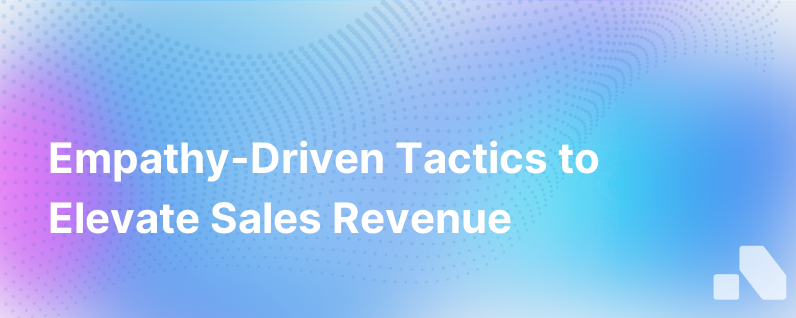
The pursuit of sales transcends mere transactions; it's about the delicate dance of forming genuine connections, understanding needs, and solving problems. It's about balancing the scales between ambition and empathy, a dynamic that echoes across the chambers of modern business.
In a digital-first world where customers are bombarded with endless choices and relentless advertising, the traditional hard sell no longer cuts through the noise. It's the companies that humanize the buying experience—those that demonstrate empathy—that win the battle for long-term loyalty and sustained revenue growth.
The ability to empathetically engage with clients and customers not only carves out a competitive advantage but also aligns sales goals with customer satisfaction. This article takes a deep dive into the art of driving revenue with empathy, and why mastery of this balancing act is critical for businesses.
Understanding Empathy in Sales: It's Personal, Not Just Business
Empathy is the capacity to understand or feel what another person is experiencing from within their frame of reference. In sales, it translates to comprehending client challenges, pains, and aspirations. It begins with attentive listening and culminates in crafting solutions that resonate on a personal level.
Many businesses claim they're customer-centric, but few execute strategies that truly put the customer's needs ahead of the company's revenue targets. To foster genuine empathy in your sales approach, consider the following principles:
- Active Listening: This is foundational. Tune into the nuances of your customer's voice, the unspoken concerns, and the hidden desires that color their speech.
- Emotional Intelligence: Read between the lines. Gauge emotions and respond with sensitivity. Sometimes, it's not about the immediate sale but about building trust.
- Authenticity: Be real. Customers spot a disingenuous pitch miles away. Authenticity in your engagements strengthens bonds with your audience.
The Balancing Act: Aligning Revenue Goals With Empathy
While empathy nurtures a fertile ground for customer loyalty, business is, at its core, about profitability and growth. Striking a balance between empathy and the drive for revenue is delicate but essential. Here's how you can maintain this equilibrium:
- Value-Based Selling: Shift focus from features to benefits. How does your product improve the customer's life or business? Align your offerings with customer values and outcomes they care about.
- Solution-Oriented Pitching: Position your selling points as a response to customer needs. Emphasize how you can alleviate their problems or hurdles, not just what's good about your product.
- Personalized Experiences: Use data and insights to tailor your interactions. Personalization, when done thoughtfully, demonstrates understanding, and that you value the customer as an individual.
Examples Where Empathy Drives Revenue:
A SaaS company, understanding a client's budgetary constraints, offered a more tailored package without unnecessary add-ons. This flexibility not only closed the deal but also led to positive word-of-mouth referrals.
A retailer, noticing a surge in returns for size mismatches, adjusted its sizing charts and provided more accurate fitting guides, resulting in increased customer satisfaction and a decrease in costly returns.
Empathy as a Revenue Driver in the Sales Process
At each stage of the sales funnel, empathy comes into play differently:
- Awareness Stage: Use empathetic content marketing strategies to demonstrate understanding of customer problems.
- Consideration Stage: Sales teams that listen more than they speak, and ask the right questions to diagnose issues, stand out.
- Decision Stage: Tailor your proposals with a consultative approach. Show customers you're invested in their success.
Empathy in the Age of AI and Automation
In a business landscape increasingly driven by AI and automation, there's a pronounced fear that empathy may lose its seat at the table. However, it's quite the opposite.
Tools like Aomni can seemingly depersonalize sales interactions but, if harnessed correctly, they can actually enhance emphatic engagements. By automating mundane tasks, they free up time for sales professionals to engage in meaningful dialogue, understand customer stories, and propose nuanced solutions that resonate on a deeper level.
For instance, Aomni's AI platform helps sales teams understand client needs efficiently, enabling more personalized and empathetic interactions. In this way, technology amplifies empathy, rather than detracting from it.
Tips for Embedding Empathy Into Your Sales Culture:
- Leadership Buy-In: Leading by example is paramount; if executives demonstrate empathy, it'll cascade down through the company.
- Ongoing Training: Equip your team with the skills to communicate and sell empathetically.
- Customer Feedback: Use customer feedback to continuously refine your approach.
- Analyze and Adapt: Use tools like Aomni for actionable insights, remember that data is only worthwhile if it leads to more empathetic customer experiences.
The Risks and Rewards of Empathetic Selling
Neglecting empathy in your sales process carries substantial risks—alienation of potential customers, damage to brand reputation, and missed opportunities for deeper customer relationships.
However, the rewards of empathetic selling are bountiful—a passionate customer base, improved sales metrics, stronger brand loyalty, and a growing reputation as a customer-first business.
Conclusion
Selling with empathy isn't about choosing between empathy and revenue—it's about synergizing the two. By placing customer needs at the heart of your sales strategy, you create a self-reinforcing loop where empathy drives loyalty, loyalty drives sales, and sales drive growth.
Empathy in sales isn't just a 'nice-to-have;' it's a revenue multiplier and perhaps the most sustainable competitive advantage any business can build. With the right balance, empathy can be the cornerstone of your value proposition, influencing every touchpoint of the customer journey and driving revenue as a result. That's the beauty of the balancing act.